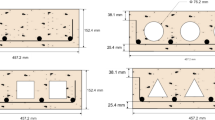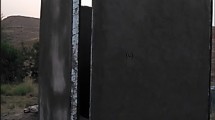Abstract
The use of concretes with supplementary cementitious materials (SCM concretes) is a mechanism to improve the sustainability of structural systems. However, most reinforced concrete (including cast-in-place and precast) structural components rely on early stiffness and strength of the concrete to resist self-weight and construction loadings after release of the formwork. In contrast to cement-only concretes, SCM concretes require more time to reach the target strength and stiffness values and therefore a structural component that does not depend on these engineering properties during construction is required. Use of concrete-filled tubes (CFTs) is a solution. With a CFT, the steel tube is able to support construction loads while the high SCM concrete fill develops its strength and stiffness. However, there are concerns about load transfer (from the concrete to the steel tube) during the development of these properties and the long-term deformations (creep) of high SCM concrete and its impact on CFT performance. This research develops models to predict the long-term (creep) response of SCM concretes and uses those predictive models to assess the long-term response of CFTs with SCM concrete fill. Three time-dependent models were developed: compressive strength, elastic modulus, and creep. The models were validated using a large SCM database and two full-scale CFTs with SCM concrete fill that were tested under sustained loading. Once verified, a parametric study was conducted. The results indicate that SCM concretes with binder ratios (total ratio of CaO/(SiO2 + Al2O3) in all binders—cement and SCMs) greater than 0.5 behaved similarly to CFTs with cement-only concrete fill.













Similar content being viewed by others
Abbreviations
- C/(S + A):
-
Weight binder ratio of CaO/(SiO2 + Al2O3)
- \( E_{\text{c}} \left( {t_{ 0} } \right) \) :
-
Elastic modulus of concrete at the instance when load first applied (MPa)
- \( E_{\text{cm}} \) :
-
Elastic modulus of concrete at 28 days (MPa)
- \( f_{\text{c}} \left( t \right) \) :
-
Concrete cylinder compressive strength at an age of t days (MPa)
- \( f_{\text{cm}} \) :
-
Concrete cylinder compressive strength at 28 days (MPa)
- h :
-
Notional size of the member (mm)
- \( J\left( {t,t_{ 0} } \right) \) :
-
Creep function, defined as the strain at time t due to a constant unit stress acting from time t 0 to time
- RH:
-
Relative humidity of ambient environment (%)
- s :
-
Coefficient which depends the type of cement
- t :
-
Age of concrete (days)
- t 0 :
-
Age of concrete at loading (days)
- t − t 0 :
-
Duration of loading (days)
- u :
-
Perimeter of the member in contact with the atmosphere
- \( \alpha_{ 1 / 2 / 3} \) :
-
Coefficients to consider the influence of the concrete strength
- \( \beta \left( {\frac{C}{S + A}} \right) \) :
-
Factor to allow for the effect of binder ratio on the notional creep coefficient
- \( \beta_{\text{cc}} \left( {\frac{C}{S + A}} \right) \) :
-
Factor to allow for the effect of binder ratio on the development of compressive strength of concrete with time
- \( \beta_{\text{cc}} \left( t \right) \) :
-
Coefficient which represents the development rate of compressive strength of concrete
- \( \beta_{\text{E}} \left( t \right) \) :
-
Coefficient which represents the development rate of elastic modulus of concrete
- \( \beta \left( {f_{\text{cm}} } \right) \) :
-
Factor to allow for the effect of concrete strength on the notional creep coefficient
- \( \beta_{\text{H}} \) :
-
Coefficient depending on the relative humidity and the notional member size
- \( \beta \left( {t_{ 0} } \right) \) :
-
Factor to allow for the effect of concrete age at loading on the notional creep coefficient
- \( \beta \left( {t,t_{ 0} } \right) \) :
-
Coefficient to describe the development of creep with time after loading
- \( \beta \left( {\frac{w}{b}} \right) \) :
-
Factor to allow for the effect of water-to-binder ratio at loading on the notional creep coefficient
- \( \varphi \left( {t,t_{ 0} } \right) \) :
-
Creep coefficient; represents the ratio of creep strain at time t to elastic strain at time t 0
- \( \varphi_{\text{RH}} \) :
-
Factor to allow for the effect of relative humidity on the notional creep coefficient
References
CEMBUREAU (2013) Activity report 2013. Brussels
Kar A, Ray I, Unnikrishnan A, Davalos JF (2013) Composite modeling to predict shrinkage of concretes containing supplementary cementitious materials from paste volumes. Constr Build Mater 43:139–155
Kuder K, Lehman D, Berman J, Hannesson G, Shogren R (2012) Mechanical properties of self consolidating concrete blended with high volumes of fly ash and slag. Constr Build Mater 34:285–295
Hannesson G, Kuder K, Shogren R, Lehman D (2012) The influence of high volume of fly ash and slag on the compressive strength of self-consolidating concrete. Constr Build Mater 30:161–168
Lehman DE, Kuder KG, Gunnarrson AK, Roeder CW, Berman JW (2014) Circular concrete-filled tubes for improved sustainability and seismic resilience. J Struct Eng ASCE 141:B4014008
Roeder CW, Lehman DE, Bishop E (2010) Strength and stiffness of circular concrete- filled tubes. J Struct Eng ASCE 136:1545–1553
Lehman DE, Roeder CW (2012) Foundation connections for circular concrete-filled tubes. J Constr Steel Res 78:212–225
Moon J, Lehman DE, Roeder CW, Lee HE (2013) Strength of circular concrete-filled tubes with and without internal reinforcement under combined loading. J Struct Eng ASCE 139:04013012
Wang YY, Chen J, Geng Y (2015) Testing and analysis of axially loaded normal-strength recycled aggregate concrete filled steel tubular stub columns. Eng Struct 86:192–212
Han LH, Li W, Bjorhovde R (2015) Developments and advanced applications of concrete-filled steel tubular (CFST) structures: members. J Constr Steel Res 100:211–228
Geng Y, Wang YY, Ranzi G, Zhang SM (2012) Time-dependent behaviour of concrete- filled steel tubular columns: analytical and comparative study. Mag Concr Res 64:55–69
Keitel A, Dimming-Osburg A, Vandewalle L, Schueremans L (2012) Selecting creep models using Bayesian methods. Mater Struct 45:1513–1533
Castel A, Foster SJ, Ng T, Sanjayan JG, Gilbert RI (2016) Creep and drying shrinkage of a blended slag and low calcium fly ash geopolymer concrete. Mater Struct 49:1619–1628
Wang J, Xu J, Gao D (2016) Numerical relationship between creep deformation coefficients of prestressed concrete beams. Mater Struct 49:1443–1453
Kou SC, Poon CS, Chan D (2008) Influence of fly ash as a cement addition on the hardened properties of recycled aggregate concrete. Mater Struct 41:1191–1201
European Committee for Standardization (CEN) EN 1992-1-1 (2004) Eurocode 2: design of concrete structures—Part 1-1: general rules and rules for buildings. Brussels: CEN
Comité Euro-International du Béton/Federation Internationale de la Pre-contrainte (CEB-FIP) CEB-FIP Model Code 1990 (1993) CEB bulletin d’Information. London: Thomas Telford
ACI Committee 209 (2009) Prediction of creep, shrinkage, and temperature effects in concrete structures (ACI 209R-92). Farmington Hills (MI): American Concrete Institute
Bazant ZP, Baweja S (2000) Creep and shrinkage prediction model for analysis and design of concrete structures: model B3. Adam Neville Symposium: creep and shrinkage-structural design effects. Farmington Hills (MI): American Concrete Institute, p. 1–83
Lohtia RP, Nautiyal BD, Jain OP (1976) Creep of fly ash concrete. ACI Proc 73:469–472
Ghosh RS, Timusk J (1981) Creep of fly ash concrete. ACI J Proc 78:351–357
Nasser KW, AI-Manaseer AA (1986) Creep of concrete containing fly ash and superplasticizer at different stress/strength ratios. ACI J Proc 83:668–673
Tikalsky PJ, Carrasquillo PM, Carrasquillo RL (1988) Strength and durability considerations affecting mix proportioning of concrete containing fly ash. ACI Mater J 85:505–511
Langley WS, Carette GG, Malhotra VM (1989) Structural Concrete incorporating high volumes of ASTM Class fly ash. ACI Mater J 86:507–514
Sivasundaram V, Carette GG, Malhotra VM (1991) Mechanical properties, creep, and resistance to diffusion of chloride ions of concretes incorporating high volumes of ASTM Class F fly ashes from seven different sources. ACI Mater J 88:407–416
Carette G, Bilodeau A, Chevrier RL, Malhotra VM (1993) Mechanical properties of concrete incorporating high volumes of fly ash from sources in the US. ACI Mater J 90:535–544
Qin HG, Pan GH, Sun W (2002) Study on the deformation properties of the high performance concrete with fly ash used in bridge. J Southeast U (Natural Sci Ed) 32:779–782
Zhao QX, Sun W, Miao CW, Tian Q, Zheng KR, Lin W (2005) Creep character of high performance concrete with ground granulated blast furnace slag and fly ash. J Wuhan U Technol 27:35–38
Zhao QX, Sun W, Miao CW (2009) Effect and mechanism of interaction between fly ash proportion and water to binder ratio on the creep characteristics of high performance concrete. China Civil Eng J 42:76–82
Zhang LL, Han JY, Zhang HY, Zhang K (2013) Impact of fly ash on the creep of high performance concrete used in bridges. J Inf Comp Sci 10:743–752
Wang JQ, Fang Z, Tang ZJ (2013) The experimental study on creep and shrinkage of high strength concrete with fly ash. Adv Mater Res 639:423–426
Wang YF, Ma YS, Zhou L (2011) Creep of FRP-wrapped concrete columns with or without fly ash under axial load. Constr Build Mater 25:697–704
Chern JC, Chan YW (1988) Deformations of concretes made with blast-furnace slag cement and ordinary Portland cement. ACI Mater J 86:372–382
Alexander MG (1994) Deformation properties of blended cement concretes containing blastfurnace slag and condensed silica fume. Adv Cem Res 6:73–81
Khatri RP, Sirivivatnanon V, Gross W (1995) Effect of different supplementary cementitious materials on mechanical properties of high performance concrete. Cem Concr Res 25:209–220
Li JY, Yao Y (2001) A study on creep and drying shrinkage of high performance concrete. Cement Concr Res 31:1203–1206
Bjegovic D, Stirmer N, Serdar M (2012) Durability properties of concrete with blended cements. Mater Corros 63:1087–1096
Geng Y, Wang YY, Chen J (2015) Time-dependent behavior of recycled aggregate concrete-filled steel tubular columns. J Struct Eng ASCE 141:04015011
Geng Y, Wang YY, Chen J (2016) Time-dependent behaviour of steel tubular columns filled with recycled coarse aggregate concrete. J Constr Steel Res 122:455–468
Ma YS, Wang YF (2012) Creep of high strength concrete filled steel tube columns. Thin Wall Struct 53:91–98
Naik TR, Singh SS, Ramme BW (1998) Mechanical properties and durability of concrete made with blended fly ash. ACI Mater J 95:454–460
Zhao HG, Peng J, Zhou MK (2005) Influence of fly ash and GGBS on volume stability of high performance concrete. J Wuhan U Tech 27:36–38
ACI 318-11 (2011) Building code requirements for structural concrete and commentary
Roeder CW, Cameron B, Brown CB (1999) Composite action in concrete filled tubes. J Struct Eng ASCE 125:477–484
Acknowledgments
Jie Chen was supported by the China Scholarship Council (CSC) and the National Natural Science Foundation of China (No. 51178146). The authors are grateful for the support.
Author information
Authors and Affiliations
Corresponding author
Appendix: Proposed creep model for SCM concrete
Appendix: Proposed creep model for SCM concrete
Equations
Rights and permissions
About this article
Cite this article
Chen, J., Kuder, K.G., Lehman, D.E. et al. Creep modeling of concretes with high volumes of supplementary cementitious materials and its application to concrete-filled tubes. Mater Struct 50, 89 (2017). https://doi.org/10.1617/s11527-016-0955-9
Received:
Accepted:
Published:
DOI: https://doi.org/10.1617/s11527-016-0955-9




